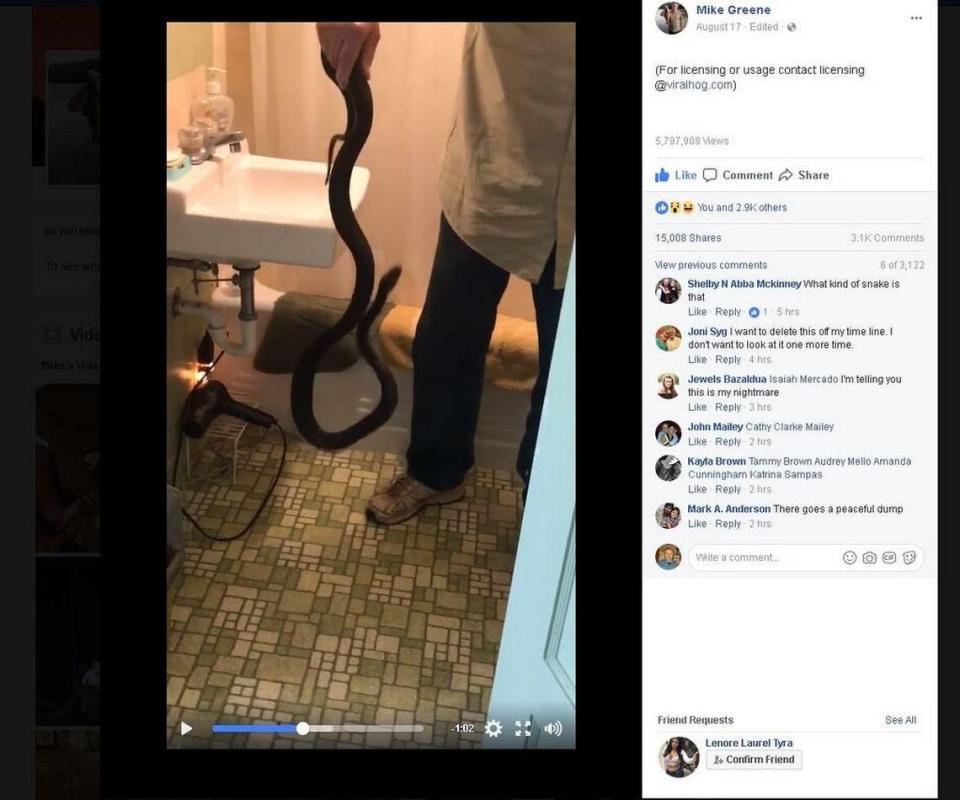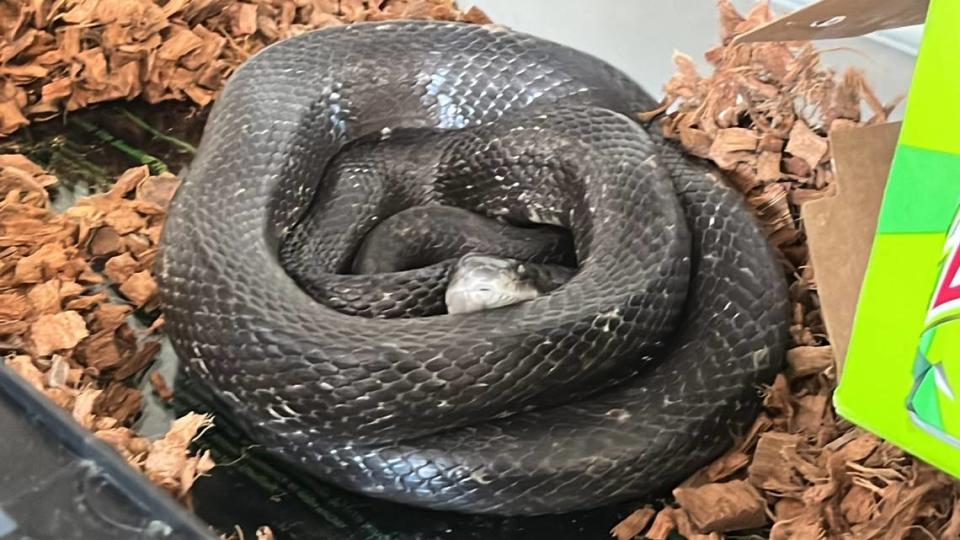Can snakes (or rats) come up through your toilet? It’s rare, but yes. Here’s how
In North Carolina, we’re used to having snakes around, and they occasionally make headlines for getting caught in some unusual situations.
For example, snakes have made national headlines this summer for popping up in toilet bowls in Texas and Arizona. A few weeks ago, a police officer pulled a “slippery suspect” from a bathroom in Graham, N.C.
“Officers responded to a home concerning a trespassing call. The caller was unsure how the trespasser had gotten inside and was surprised to discover the slippery suspect in the bathroom,” the Graham Police Department posted on Facebook in July.
“Officers cleared the residence, and after a brief standoff, Sgt. Way made the apprehension. The suspect was removed and relocated without incident.”
We, of course, got to wondering: Does this happen often? And can it happen to me?
We talked to our snake experts at the NC Wildlife Resources Commission to get answers.
Can snakes come up through your toilet in North Carolina?
Yes, but it’s very unlikely.
There are two situations for snakes to find themselves in toilets:
1. A snake sought out drinking water after coming into your home, said Jeff Hall, biologist and snake expert with the NC Wildlife Resources Commission.
Long, climbing snakes can slither up to your toilet bowl to quench their thirst. This is the most common (though still very uncommon) scenario.
2. A snake entered your home through the pipes of the toilet.
“In an even rarer case, a snake might have entered through an uncovered sewer or ventilation pipe hoping to find rodent prey or shelter, but they don’t live in or intentionally try to get into sewer systems,” Hall said.
“Any snake that finds itself trapped in a sewer line very likely just wants to get back to where it originally came from and has no desire to interact with people”
Snakes on a plane? More like snake in a drain.
An Arizona woman came home to this slithery creature in her toilet after many days away and she was not pleased. pic.twitter.com/4AzVYaUa7L— The Associated Press (@AP) August 11, 2023
Which snakes are the most likely to be in your toilet?
These situations most often include escaped pet snakes, Hall said.
Rat snakes are the most possible contenders in the Carolinas, as they’re great climbers and can fall into unscreened ventilation pipes on your roof.
(The long, black snake found in the Graham bathroom this month was a rat snake, said Falyn Owens, wildlife biologist for NCWRC.)
“Any snake that gets into a house that is long enough to reach up into a toilet might end up there, so this would primarily include racers, garter snakes and water snakes,” Hall said.
All of those snakes are nonvenomous. North Carolina’s venomous snake species are heavy bodied, so they tend to be worse at climbing.

Can a venomous copperhead come up through your toilet in NC?
Yes, but it’s incredibly rare.
If this were to happen (which it really, really shouldn’t), it would be because a copperhead got into your house and needed a drink of water.
“I suppose it’s at least possible that a copperhead might get into a house and find itself dehydrated, but I would think that would be extremely rare,” Hall said.
Can rats or other animals come into your house through the toilet?
Yes. Other animals can include rats and frogs.
“Animals that like dark, enclosed, or moist places are more likely to enter an open sewer pipe, but again, this type of situation happens extremely rarely and is easily preventable,” Owens said.
None of these animals are particularly “dangerous,” Owens said, though animals that feel threatened can bite.

How to keep snakes, rats from coming up through your toilet
There are already built-in safeguards to your plumbing to help prevent this, but there’s more you can do to extra avoid seeing a snake or other unwanted creature at the bottom of the bowl.
“Septic and sewer systems are intended to be closed systems, and there are also toxic gasses that exist within these systems that would typically prevent most animals from surviving,” Owens said.
This is why plumbing usually involves “U”-bends somewhere, as this blocks the gasses from reaching people and causing harm, she said.
Here are some steps you can take:
▪ Seal entry points around your house. Look especially around doors, windows, crawl spaces and fascia board.
“Snakes, and other wildlife, are pretty amazing at squeezing into the smallest of cracks and openings. Seal all such openings to prevent wildlife from accessing human habitations,” Owens said.
▪ Check your sewer cleanouts. Make sure they’re securely closed.
▪ Check ventilation pipes on the roof. They should be fitted with a screen that lets gasses escape but keeps the critters out, Owens said.
Found a snake in your toilet? Here’s what to do
Remember, this is super rare. But if it does happen to you, Owens recommends the following instructions:
1. Assess if the snake is venomous.
The News & Observer has a number of stories about snake identification, including for both venomous and nonvenomous snakes in the Carolinas.
Owens also recommends consulting herpsofnc.org/snakes for photos and descriptions.
If the snake is nonvenomous…
2. Safely remove the snake from your toilet. You can move it out of the house and release it into the yard or woods.
“Getting the animal back outside (or into an enclosure, in the case of an escaped pet) is the first priority,” Owens said.
3. Call a wildlife agent, if you prefer. A licensed wildlife control agent can help remove the animal from the house if someone does not feel comfortable doing it themselves.
For more information about this, you can visit ncwildlife.org/Trapping/Wildlife-Control-Agent.
Why copperhead snakes like coming onto our front porches — and how to keep them away
It’s ‘baby copperhead season’ in NC. Here’s what to know about the juvenile snakes

